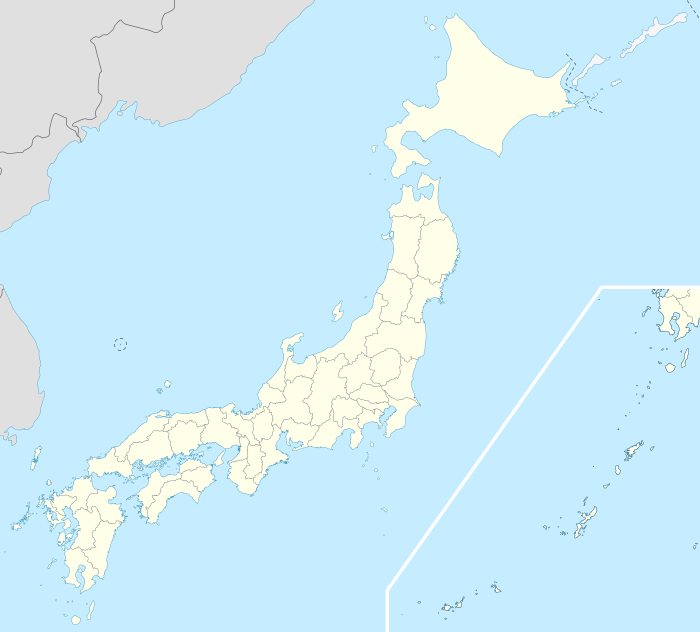Naha Air Base
| Naha Air Base | |||||||||||
|---|---|---|---|---|---|---|---|---|---|---|---|
|
PACAF 16th Fighter-Interceptor Squadron F-102 interceptors on the flight line, 1966 | |||||||||||
| IATA: OKA – ICAO: ROAH | |||||||||||
| Summary | |||||||||||
| Airport type | Military | ||||||||||
| Serves | Naha, Okinawa, Japan | ||||||||||
| Elevation AMSL | 11 ft / 3 m | ||||||||||
| Coordinates | 26°11′45″N 127°38′45″E / 26.19583°N 127.64583°ECoordinates: 26°11′45″N 127°38′45″E / 26.19583°N 127.64583°E | ||||||||||
| Map | |||||||||||
 ROAH Location in Japan | |||||||||||
| Runways | |||||||||||
| |||||||||||
Naha Air Base (那覇基地 Naha Kichi), formally known as the Kōkū Jieitai Naha Kichi (航空自衛隊那覇基地), is an air base of the Japan Air Self-Defense Force formerly under control of the United States Air Force. It is located at Naha Airport on the Oroku Peninsula in Naha, Okinawa, Japan.[2][3]
History
Naha Airfield was constructed in 1933 as Oroku Naval Air Base, an air base of the Imperial Japanese Navy (IJN). In 1936 control of the air base was transferred to the Japanese Ministry of Communications and formally renamed Naha Airfield. In 1942 control of the air base again reverted to the IJN, which reverted the name of the installation to Oroku Naval Air Base. The facility was captured by the United States during World War II in the Battle of Okinawa on April 1, 1945.[2]
After World War II the installation became a major United States Air Force (USAF) base under the operational control of Pacific Air Forces (PACAF), and was known as Naha Air Base (Naha AB). The installation became a joint military-civilian air field in 1954 with the resumption of civilian air service between Tokyo and Okinawa. The USAF ended its use of Naha AB on 31 May 1971 and control of civil aviation was transferred to the Japanese Ministry of Transportation, which established Naha Airport on the site; control of the military air field was officially transferred to the Japan Air Self-Defense Force in 1979.[2] As of 2015, "Lt. Colonel George W. Mickey, the last US Military Base Commander at Naha AB.
Japanese F-15s have been stationed there, with a second squadron of F-15s added in 2014.[4]
Former units
Major USAF units assigned to Naha AB were:
- Headquarters, 301st Fighter Wing, 12 May 1947 – 20 January 1949
- 51st Fighter Group, 22 May 1947 – 22 September 1950
- 16th Fighter Squadron, 22 May 1947-22 September 1950 (F-80 Shooting Star)
- 25th Fighter Squadron, 22 May 1947-22 September 1950 (F-80 Shooting Star)
- 26th Fighter Squadron, 22 May 1947-22 September 1950 (F-80 Shooting Star)
- 4th Fighter (All-Weather) Squadron, 19 August 1948 – 16 February 1953 (P-61 Black Widow, F-82 Twin Mustang)
- Assigned to: 347th Fighter (later Fighter-All Weather) Group, Kadena Air Base, Okinawa
- Attached to: 51st Fighter (later Fighter-Interceptor) Group), 19 August 1948
- Assigned to: Twentieth Air Force, June 24, 1950
- Attached to: 51st Fighter-Interceptor Wing, June 24, 1950
- Flight of 8 aircraft attached to 347th Provisional Fighter Group (All Weather), Itazuke Air Base, Japan, June 27 – July 5, 1950 for combat missions in Korea
- Attached to: 6302d Air Base Group, September 20, 1950
- Attached to: 6351st Air Base Wing, June 25, 1951–16 February 1953
- Attached to: 51st Fighter-Interceptor Wing, June 24, 1950
- Redesignated: 4th Fighter-Interceptor Squadron (F-94 Starfire)
- Assigned to: 6351st Air Base Wing, 25 February-1 August 1954
- 6351st Air Base Wing, 22 September 1950 – 1 August 1954
- 51st Fighter-Interceptor Wing, 1 August 1954 – 31 May 1971
- 16th Fighter-Interceptor Squadron, 1 August 1954-31 May 1971, (F-86 Sabre, F-102 Delta Dagger)
- 25th Fighter-Interceptor Squadron, 1 August 1954-8 June 1960, (F-86 Sabre)
- 26th Fighter-Interceptor Squadron, 1 August 1954-11 July 1955, (F-86 Sabre)
- 623rd Aircraft Control & Warning Squadron, 20 December 1957 - 8 Jul 1973
- Assigned to: 313th Air Division, 15 Mar 1955 - 17 Jul 1960
- Attached to: 51st Fighter-Interceptor Wing, 27 Mar 1958 - 17 July 1960
- Assigned to: 51st Fighter-Interceptor Wing, 18 July 1960 - 20 May 1971
- Assigned to: 18th Tactical Fighter Wing, 21 May 1971 - 8 July 1973
- 21st Troop Carrier (Tactical Airlift) Squadron 15 November 1958 – 31 May 1971, (C-119 Flying Boxcar, C-130 Hercules)
- Assigned to: 483rd Troop Carrier Wing (1958-1960); 315th Air Division (1960 - 1963) 6315th Operations Group (1963-1966); 374th Tactical Airlift Wing (1966 - 1971)
- 35th Troop Carrier Squadron (315th Air Division), 8 January 1963 – 8 August 1966, (C-130 Hercules)
- 817th Troop Carrier Squadron (315th Air Division), 25 June 1960 – 8 August 1966, (C-130 Hercules)
Current units
Naha AB currently hosts JASDF units flying modified F-15J/DJ fighter aircraft, Kawasaki T-4 trainers, UH-60J Black Hawk and CH-47J Chinook helicopters. Units of the Japan Maritime Self-Defense Force are also based at Naha, flying the P-3 Orion patrol aircraft. The Japan Ground Self-Defense Force, Okinawa Prefectural Police, and the Japan Coast Guard also utilize facilities at Naha Airport.
As of 2013, funding in the region of ¥0.3 billion has been requested for preparing the base to host JASDF E-2C aircraft, including ¥70million for new repair and maintenance facilities.[5]
See also
References
![]() This article incorporates public domain material from the Air Force Historical Research Agency website http://www.afhra.af.mil/.
This article incorporates public domain material from the Air Force Historical Research Agency website http://www.afhra.af.mil/.
- ↑ AIS Japan
- 1 2 3 "那覇空港" [Naha Airport]. Nihon Rekishi Chimei Taikei (in Japanese). Tokyo: Shogakukan. 2013. OCLC 173191044. Retrieved 2013-06-07.
- ↑ 基地紹介 (in Japanese). Tokyo, Japan: Ministry of Defense. 2012. Retrieved June 7, 2013.
- ↑ Fackler, Martin; Forsythe, Michael (8 March 205). "In a Test of Wills, Japanese Fighter Pilots Confront Chinese". New York Times. Retrieved 10 March 2015. Check date values in:
|date=(help) - ↑ Defense Programs and Budgets of Japan; Overview of FY2013 Budget Request Downloaded from Ministry of Defense english website on June 5th, 2013.
